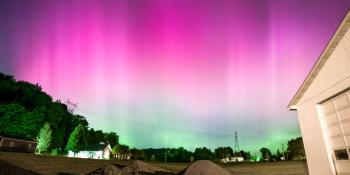Viewing archive of piątek, 18 stycznia 2013
Raport aktywności słonecznej
Any mentioned solar flare in this report has a scaling factor applied by the Space Weather Prediction Center (SWPC). Because of the SWPC scaling factor, solar flares are reported as 42% smaller than for the science quality data. The scaling factor has been removed from our archived solar flare data to reflect the true physical units.
Raport aktywności słoneczno- geomagnetycznej 2013 Jan 18 2200 UTCPrzygotowane przez NOAA © SWPC i przetworzone przez SpaceWeatherLive.com
Połączenie raportów USAF/NOAA o słonecznej i geofizycznej aktywności
Numer SDF 18 wydany w 2200Z na 18 Jan 2013IA. Analiza aktywności regionów słonecznych i aktywność od 17-2100Z do 18-2100Z Solar activity has been at low levels for the past 24 hours.
The largest solar event of the period was a C5 event observed at
18/1707Z from Region 1654 (N07W59). There are currently 3 numbered
sunspot regions on the disk.
IB. Prognoza aktywności słonecznej
Solar activity is expected to be low with
a slight chance for M-class flares on day one (19 Jan). Solar activity
is likely to be low on days two and three (20 - 21 Jan).
IIA. Podsumowanie aktywności geofizycznej 17-2100Z do 18-2100Z
The geomagnetic
field has been at quiet to unsettled levels for the past 24 hours. Solar
wind speed, as measured by the ACE spacecraft, reached a peak speed of
480 km/s at 18/1850Z. Total IMF reached 17.2 nT at 18/1132Z. The maximum
southward component of Bz reached -9.3 nT at 17/2351Z. Electrons greater
than 2 MeV at geosynchronous orbit reached a peak level of 2057 pfu.
IIB. Prognoza aktywności geofizycznej
The geomagnetic field is expected
to remain mostly quiet until late on day one (19 Jan), when the
geomagnetic field increases to quiet to unsettled conditions with a
chance for an active period with the arrival of the 16 Jan CME.
Unsettled to active conditions with a slight chance for a minor storm
period exists early on day two (20 Jan) with the 16 Jan CME. Conditions
begin to decrease to predominately quiet to unsettled levels starting
midday on day two (20 Jan). Conditions are expected to return to
predominately quiet with a possible unsettled period on day three (21
Jan).
III. Prawdopodobieństwa zdarzenia 19 Jan do 21 Jan
| Klasa M | 10% | 05% | 01% |
| Klasa X | 01% | 01% | 01% |
| Proton | 01% | 01% | 01% |
| PCAF | green | ||
IV. Przepływ 10,7 cm z Penticton
Zaobserwowano 18 Jan 115 Przewidywane 19 Jan-21 Jan 115/115/110 Średnia z 90 dni 18 Jan 122
V. Indeks geomagnetyczny A
Zaobserwowano Afr/Ap 17 Jan 012/015 Szacowane Afr/Ap 18 Jan 009/009 Przewidywane Afr/Ap 19 Jan-21 Jan 009/012-015/018-007/012
VI. Prawdopodobieństwa aktywności geomagnetycznej 19 Jan do 21 Jan
| A. Średnie szerokości geograficzne | |||
|---|---|---|---|
| Aktywne | 25% | 35% | 15% |
| Słaba burza | 10% | 15% | 05% |
| Bardzo znacząca burza | 01% | 05% | 01% |
| B. Wysokie szerokości geograficzne | |||
|---|---|---|---|
| Aktywne | 15% | 10% | 15% |
| Słaba burza | 30% | 30% | 25% |
| Bardzo znacząca burza | 35% | 55% | 20% |
All times in UTC
<< Idź do codziennego przeglądu
Najnowsze wiadomości
Najnowsze wiadomości z forum
Space Weather Memes 359Records from current activity discussion 12A little bit about our hobby for the general public 4suggestion for app additional feature 11May 2024 Geomagnetic Storms from AR 13664 (2) 320
Więcej tematówWesprzyj SpaceWeatherLive.com!
Wielu ludzi odwiedza SpaceWeatherLive aby śledzić aktywność słoneczną lub sprawdzić czy jest szansa na zaobserwowanie zorzy polarnej. Niestety, większy ruch na stronie oznacza większe koszty utrzymania serwera. Dlatego, jeśli jesteś zadowolony ze strony SpaceWeatherLive, zachęcamy do wspierania nas finansowo. Dzięki temu będziemy mogli utrzymać naszą stronę.

Fakty na temat pogody kosmicznej
| Ostatnie rozbłyski klasy X | 2024/05/15 | X2.9 |
| Ostatnie rozbłyski klasy M | 2024/05/17 | M7.1 |
| Ostatnia burza geomagnetyczna | 2024/05/17 | Kp6 (G2) |
| Spotless days | |
|---|---|
| Ostatni dzień bez skazy | 2022/06/08 |
| Monthly mean Sunspot Number | |
|---|---|
| kwietnia 2024 | 136.5 +31.6 |
| maja 2024 | 157.2 +20.7 |
| Last 30 days | 174.3 +64.2 |


